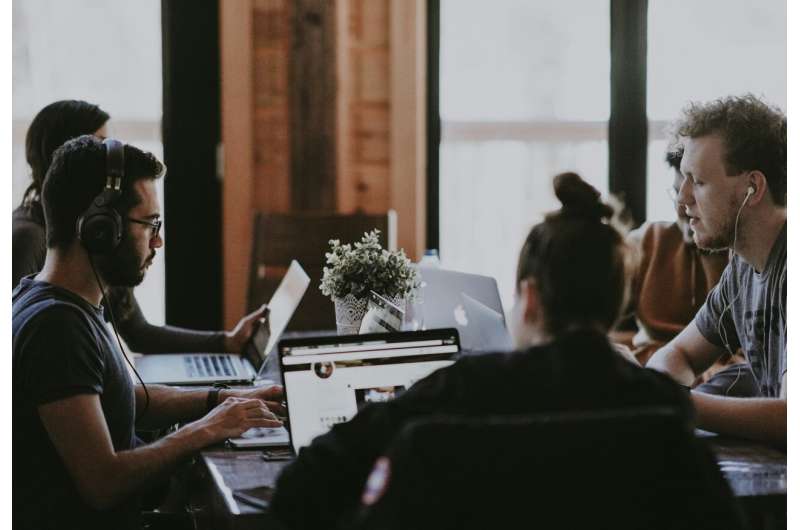This article has been reviewed according to Science X's editorial process and policies. Editors have highlighted the following attributes while ensuring the content's credibility:
fact-checked
trusted source
proofread
Post mergers and acquisitions, will employees leave or stay? Researchers say 'just ask AI'

Within knowledge-intensive industries like tech, there is an almost insatiable demand for highly skilled employees, such as software engineers and app developers. Need for talent often motivates mergers and acquisitions (M&A), in a process colloquially known as "acqui-hiring."
As is well-known, however, differences in company culture and organizational misalignments during the merging process may result in talent turnover, tension, and increased potential of failure.
In a recent working paper published in SSRN Electronic Journal, Jingyuan Yang, an information systems and operations management professor at the Donald G. Costello College of Business at George Mason University, discovers how to efficiently predict employee turnover using an innovative AI-driven approach. This paper was also co-authored by Denghui Zhang from Stevens Institute of Technology, and Hao Zhong from ESCP Business School in Paris.
"The primary objective of this study is to examine the effects of M&A on employee turnover across diverse business sectors, and to draw generalizable insights into turnover patterns," Yang states.
Within this study, the researchers utilized a large-scale real-world data-set which had information on the histories of acquired employees as well as information on the M&A firms for their method test. The researchers then developed a "dual-fit heterogeneous graph neural network" to predict talent turnover in the merging phase of companies.
Through data analysis, they measured an Organization to Organization fit (O-O) which compares the similarities between the two companies, and a Person to Organization fit (P-O), which analyzes compatibility between individual job functions and the new company culture.
Yang emphasizes the distinction between this study and traditional M&A research, which "only focuses on firm-to-firm relationships, lacking the perspective on employee compatibility," Yang says.
The O-O fit and the P-O fit were converted into a graph structure, which can be used to quantify the overall fit of the two companies. This score, in turn, determines the likely rate of turnover for specific job titles.
The researchers found that the predictive performance of their solution surpassed four conventional machine-learning models trained on the same data, as well as three existing graph neural network models.
Based on existing research, Yang finds that an astonishing "30 percent of merging acquirees left within three years," underscoring the severity of the problem. In Yang's perspective, this seems to be a great loss and failure of an hiring-oriented acquisition.
But what does Yang's approach mean for companies that may be involved in "acqui-hiring" in the future, and want to avoid the same fate? For Yang, this AI model serves as a potential tool that may aid organizations' decision making and effectiveness overall.
"If they have this information beforehand, I think this will be very helpful for them to make the merging decision and also to see if this is the most effective way to hire and retain the team."
She states that this predictive model answers the question of "Which type of employee will be affected the most and the HR team can quickly identify if the desired employee will leave or not." Also, the two fits contain information useful in evaluating the M&A process, to see if "at the company level there is high compatibility, and the individual level to see if the future acquired employee will be satisfied and stay at a company."
Accurate predictions of turnover rates by job function also allow acquiring companies to take proactive steps to retain mission-critical employees who might be at high risk of quitting. "It helps them to determine their retention package…[there are] a lot of strategies to pinpoint the employees they really want to acquire," Yang says.
"This can help them to have the right expectation. Companies need to consider the estimated cost of their retention package prior to entering into the M&A deal."
But given the high probability of turnover and the resulting retention costs, is "acqui-hiring" even a good idea in most cases? "I think it's going to be trending for a long time, because it still brings a lot of benefits. Acquirers get not only the unique products and techniques, but there's a soft knowledge set among acquired employees that is really valuable. So I think this strategy will be continue to be prevalent in the technology field," Yang says.
More information: Denghui Zhang et al, Acqui-hiring or Acqui-quitting: Data-driven Post-M&A Turnover Prediction via a Dual-fit Model, SSRN Electronic Journal (2023). DOI: 10.2139/ssrn.4389063
Provided by George Mason University





















